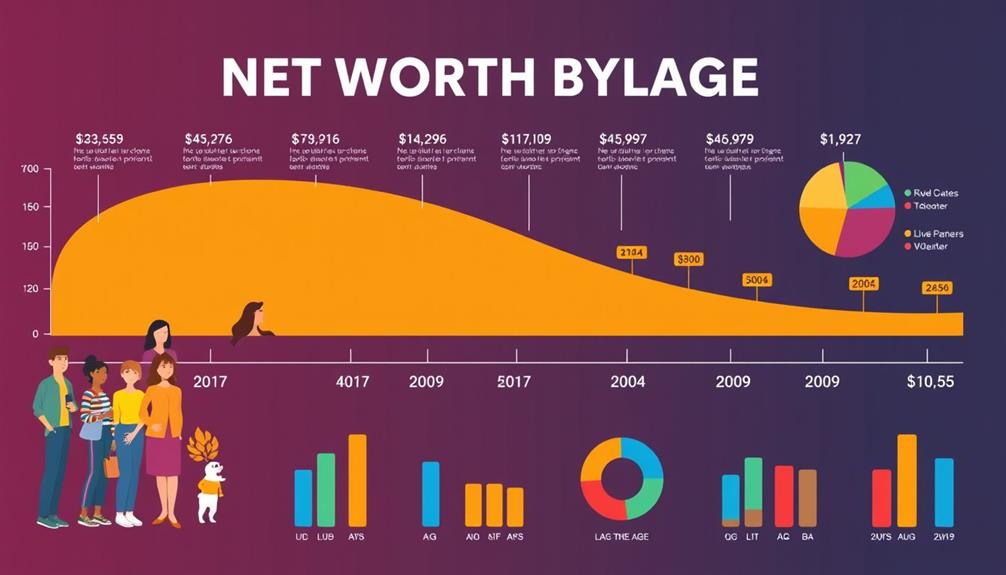Tracking your net worth by age lets you see how you measure up against your peers in the UK. In your 20s, the average net worth hovers around £15,000, often impacted by student debt. By your 30s, this can rise considerably, hitting around £180,000 by retirement. As you approach 55-64, average net worth reaches about £600,000, thanks to strong pension contributions. Understanding how your net worth evolves with age helps you spot both successes and growth areas. Curious to discover strategies to boost your financial standing? There's plenty more to uncover about optimizing your wealth over time.
Key Takeaways
- Young adults (25-34) have an average net worth of £15,000, often impacted by student debt.
- By retirement, property wealth typically peaks at £180,000, highlighting the importance of home ownership.
- Ages 45-54 average net worth is £250,000, benefiting from increased earnings and savings.
- Ages 55-64 see average net worth rise to £600,000, reflecting strong pension contributions and asset accumulation.
- Average household savings in the UK is approximately £76,301, but median savings reveal significant wealth inequality at £12,500.
Understanding Net Worth
Net worth is fundamentally the financial snapshot of your life, calculated by subtracting your total liabilities from your total assets. It's a vital metric to determine your financial health. Understanding your net worth allows you to see where you stand regarding financial wealth, giving you a clearer picture of your economic standing.
This assessment can also help identify areas for improvement, such as creating a personal budget or adjusting your investment strategy.
Your net worth comprises various components, including property wealth, private pension wealth, and financial wealth. Each of these assets plays an essential role in your overall financial situation. By tracking your net worth over time, you gain valuable insights into your financial trajectory rather than just comparing yourself to others.
While younger adults, particularly those aged 25 to 34, often struggle with challenges like student debt that can hinder their financial progress, significant growth in net worth typically occurs between ages 45 and 65.
This understanding can empower you to strategize your financial planning effectively across different life stages. Recognizing how your wealth categories grow can help you set realistic goals and make informed decisions that align with your long-term financial aspirations.
Net Worth Trends by Age

Understanding how net worth trends shift with age can provide valuable insights into your financial journey. As you navigate through different life stages, your financial wealth is likely to evolve markedly. For instance, young adults aged 25 to 34 often grapple with student debt, which can hinder their net worth. However, as you reach your mid-30s, median property wealth starts to rise, peaking at around £180,000 by retirement.
The most substantial growth in net worth typically occurs between ages 45 and 65, fueled by higher earnings and increased pension contributions. By age 55-59, the average private pension wealth reaches approximately £418,000, showcasing the benefits of early and consistent saving.
Here's a quick overview of net worth trends by age:
| Age Range | Average Net Worth | Key Factors |
|---|---|---|
| 25-34 | £15,000 | Student debt impacts |
| 35-44 | £70,000 | Rising property wealth |
| 45-54 | £250,000 | Increased earnings |
| 55-64 | £600,000 | Strong pension contributions |
These trends highlight the importance of financial planning as you age.
Wealth Accumulation Strategies

When it comes to building your wealth, starting early with investments is vital.
Investing in alternative assets, such as gold, can provide diversification and protection against market volatility, making it an essential strategy for long-term financial security.
You should also focus on managing debt effectively, as this can free up resources for better financial growth.
Early Investment Necessities
To build wealth early in life, it's essential to focus on strategic investments that lay a strong financial foundation. By prioritizing the right steps, you can enhance your net worth greatly. Here are four vital early investment necessities:
1. Invest in Private Pension Wealth: Start contributing to a private pension early. The sooner you begin, the more you can benefit from compound interest over time.
Additionally, consider diversifying your retirement portfolio by exploring options like a Gold IRA, which can provide a hedge against inflation and market volatility.
2. Acquire Financial Assets: Consider investing in stocks or mutual funds. These can provide passive income and help you grow your wealth without relying solely on your salary.
3. Consider Rental Properties: Investing in real estate can create a steady income stream. Rental properties not only appreciate over time but also generate cash flow.
4. Minimize Depreciative Assets: Be mindful of your spending. Focus on necessary expenses and avoid purchases that lose value quickly. This will keep your net worth healthy.
Debt Management Techniques
Effective debt management techniques are vital for building wealth and enhancing your net worth. Eliminating high-interest debt should be your top priority, as it frees up funds you can redirect toward savings and investments instead of wasting on interest payments.
If you're a young adult aged 25 to 34, you know that student debt can greatly hinder your net wealth. Create a targeted strategy to minimize its impact; consider refinancing options or setting up a repayment plan that fits your budget. Additionally, understanding the risks and rewards of Bitcoin IRAs can provide alternative investment opportunities to help grow your wealth.
When it comes to mortgages, assess whether leveraging your assets for growth outweighs the benefits of clearing debt. It's a balance that can affect your overall financial health.
Additionally, controlling your physical wealth is essential: limit spending on depreciative assets like luxury items. This helps maintain a higher net worth and eases your financial burden.
Prioritize essential spending and cut down on unnecessary expenses. By doing so, you'll allocate more resources toward wealth-building opportunities.
Passive Income Generation
Passive income generation is a powerful strategy for wealth accumulation that can transform your financial future. By establishing streams of passive income, you can greatly enhance your financial wealth and work toward early retirement.
One effective method to bolster your savings is through gold investment strategies, which can provide a hedge against inflation and market fluctuations.
Here are some effective ways to generate passive income:
- Invest in Rental Properties: Owning real estate can provide consistent rental income while appreciating in value over time.
- Dividend-Yielding Stocks: Invest in stocks that pay dividends, allowing you to earn money without selling your shares.
- Build a Diversified Portfolio: Combine real estate and equities to create sustainable passive income streams that can exceed median earnings levels.
- Reinvest Earnings: Use the compounding effect by reinvesting dividends and rental income, especially if you start in your 20s or 30s.
To maximize your passive income potential, focus on cash flow management and keep your liabilities low.
Aggressive pension contributions are also essential for long-term passive income that covers your living expenses.
Investment Approaches for Independence

To achieve true independence, you need to focus on aggressive pension contributions and smartly diversify your investment portfolio.
Exploring options like a Gold IRA can be a strategic move for long-term wealth building, as it allows you to invest in precious metals while benefiting from tax advantages Noble Gold's offerings.
By doing this, you can create multiple streams of passive income that will support you in the long run.
It's all about making your money work harder for you from the start.
Aggressive Pension Contributions
When it comes to securing your financial future, aggressive pension contributions play an essential role in building a substantial retirement fund. By maximizing your contributions, you can take advantage of employer matching schemes and the power of compounding returns, ultimately leading to significant wealth accumulation.
Additionally, exploring options like a Gold IRA rollover can provide further diversification and protection against market volatility. Here are four key reasons to contemplate aggressive pension contributions:
- Early Benefits: Contributing early allows your investments to grow, enhancing your overall pension wealth.
- Employer Matching: Take full advantage of company pension schemes that offer matching contributions, effectively boosting your savings.
- Financial Independence: A robust pension plan can help you achieve a comfortable retirement income, as the average pension income for UK households stands at around £30,000.
- Passive Income Generation: Developing an early retirement investment strategy through aggressive pension contributions can create passive income, ensuring you cover living costs after retiring.
For those aged 55-59, the average private pension wealth is about £418,000, emphasizing the necessity of proactive contributions.
Start focusing on your pension today, and you'll be better positioned to enjoy a financially secure retirement.
Diversifying Investment Portfolio
Maximizing your pension contributions is just one piece of the puzzle in securing your financial future. Diversifying your investment portfolio is equally vital, especially as you approach retirement. By spreading your investments across various asset classes, you can mitigate risks and enhance potential returns.
Here's a quick look at how different assets can contribute to your financial well-being:
| Asset Class | Importance |
|---|---|
| Stocks | Offers growth potential |
| Property | Provides rental yields |
| Cash | Guarantees liquidity |
| Bonds | Offers stability and income |
Focusing on rental yields from property and dividend yields from stocks will create passive income streams, which are essential to covering living costs in retirement. Regularly rebalancing your portfolio helps you adapt to changing market conditions and personal financial goals, guaranteeing your wealth growth exceeds median levels.
Generating Passive Income
Generating Passive Income (Investment Approaches for Independence)
Many people overlook the importance of generating passive income as a key component of financial independence. By focusing on creating income streams that require minimal active involvement, you can considerably enhance your financial stability.
One effective method to contemplate is diversifying your investments, including options like precious metals, which can act as a protective hedge against economic downturns and inflation. Additionally, exploring strategies for Gold IRA rollovers can further secure your financial future.
Here are some effective strategies to contemplate:
- Invest in Rental Properties: Real estate can provide reliable rental yields, contributing to your overall passive income.
- Dividend Stocks: Contemplate investing in stocks and shares that offer dividends. These can generate regular income while your investments appreciate.
- Maximize Pension Contributions: Start early to take advantage of compound growth. This reduces the need for large withdrawals later and enhances your savings for retirement.
- Eliminate High-Interest Debt: Before diving into investments, pay off any high-interest debts. This guarantees that your wealth-building efforts are effective and sustainable.
Shifting your focus to passive income streams can provide the necessary cash flow to cover living costs, reducing your reliance on active income sources.
Personal Financial Education

Understanding personal finance is essential for steering your financial journey effectively. It's crucial to grasp your financial trajectory rather than rely solely on average wealth metrics, which can often mislead. For example, while the average household savings in the UK sits at around £76,301, the median of £12,500 is a more realistic benchmark for you.
Wealth typically increases with age, especially between 40-44, partly due to rising pension contributions and property value. Prioritizing financial literacy in your twenties to forties can greatly boost your net worth.
To develop effective savings strategies, you should understand the types of savings accounts available. Here's a simple overview:
| Type of Account | Benefits | Considerations |
|---|---|---|
| Cash ISAs | Tax-free interest | Limited annual contribution |
| Stocks & Shares ISAs | Potential for higher returns | Market risk |
| Regular Savings | Predictable growth | Lower interest rates |
Comparative Wealth Insights

Comparing wealth across different age groups reveals stark disparities that can markedly impact your financial planning. You might find it surprising how age influences net worth, especially when considering the following insights:
- The average household savings in the UK is £76,301, but the median savings drop to £12,500, highlighting significant wealth inequality. This disparity can be further understood through the lens of sector performance metrics, which can vary widely across age groups and industries.
- Wealth typically increases with age, particularly in the 40-44 age group, where both savings and property values tend to rise sharply.
- For those aged 55-59, average private pension wealth reaches about £418,000, underscoring the essential role of pension planning in building individual savings.
- Property wealth peaks at £180,000 for retirees, proving that home ownership is crucial for net worth in later life.
These disparities illustrate that your financial strategy shouldn't only consider your current savings but also how your age and life stage can affect your wealth accumulation.
Understanding these comparative insights can guide you in making informed decisions about saving, investing, and planning for retirement, ultimately helping you compare favorably with your peers.
Conclusion
As you navigate your financial journey, remember that net worth isn't just a number; it's a reflection of your choices and dreams. Like a river shaping the land, your wealth accumulates through patience and smart decisions. Whether you're just starting out or climbing higher, each step you take builds your unique financial landscape. Embrace learning and adapt your strategies, and you'll find yourself thriving alongside your peers, creating a future that sparkles with potential. Consistency is key, and tracking your progress allows you to celebrate milestones while adjusting your course when needed. Consider incorporating tools or strategies, like monopoly go net worth upgrades, to gamify your financial growth and keep yourself motivated. With focus and determination, your journey can turn into a legacy that inspires others to build their own pathways to success.










